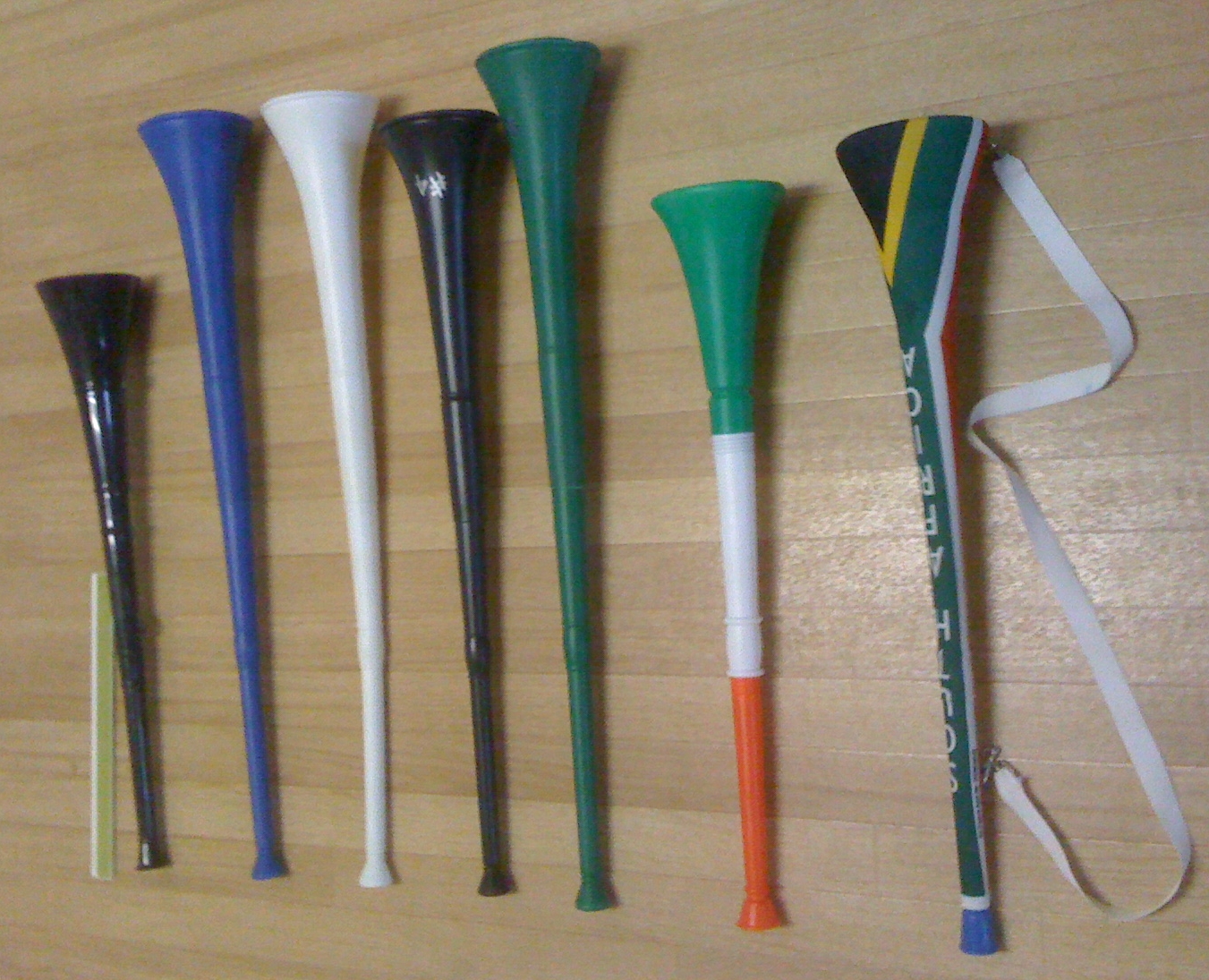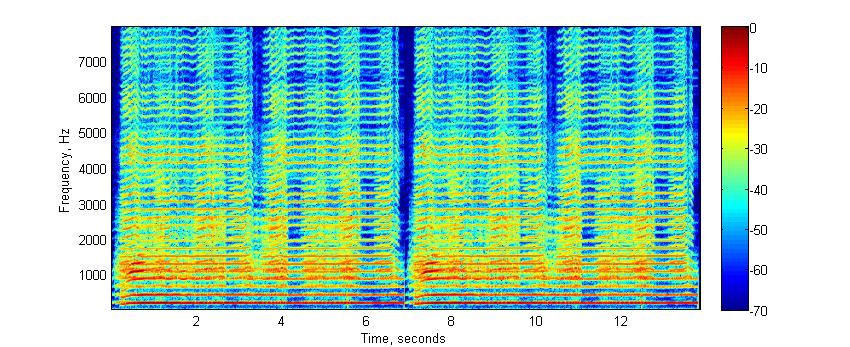
Figure 1 - A collection of Vuvuzela’s; the one on the far right was used at matches during the 2010 World Cup in South Africa.
Kenneth A. Cunefare - ken.cunefare@me.gatech.edu
G. W. Woodruff School of Mechanical Engineering
The Georgia Institute of Technology
Atlanta, GA 30332-0405
Richard Ruhala - rruhala@spsu.edu
Laura Ruhala - lruhala@spsu.edu
Southern Polytechnic State University
Marietta, GA 30060
Tina Ortkiese - tortkiese@arpeggioacoustics.com
Division of Engineering
Arpeggio Acoustic Consulting, LLC
Hampton, GA 30228
Popular version of paper 5aNSb1
Presented Friday morning, November 4, 2011
162nd ASA Meeting, San Diego, Calif.
Vuvuzelas are inexpensive horns that became a part of the American and world vocabulary during the 2010 World Cup held in South Africa, though horns of the style have been used for decades in the States and elsewhere. During the World Cup, spectators played these horns throughout the games, causing noise complaints from athletes and spectators alike, including television listeners. The Vuvuzelas and similar horns are sold in the United States and other countries, and there is concern that they will create a related noise problem at future sporting events. Indeed, the lead author’s first experience with Vuvuzela’s pre-dated the World Cup, when he attended an “International Friendly” match between Club America and AC Milan at the Georgia Dome in Atlanta (Club America won, 2-1); the number of horns in play at that match was a foreshadowing of what was seen during the World Cup.
But what is a Vuvuzela? Figure 1 depicts several examples of these inexpensive horns. These horns were purchased from internet-based vendors, as well as at the 2010 World Cup. There is no standardized form for these horns; they examples in the figure range from 0.6 to 0.75 m in length, and their profiles (their geometric shape or “flare”) are not the same. Since the horns are each different, each will have a somewhat different sound when played. While the recent popular name for these horns, Vuvuzela, appears to be of South African origin, horns of this style have existed for centuries, and have long been available even in the United States as “stadium horns.” What has happened, though, to increase their visibility is their massed use at sporting events and attendant publicity, especially related to soccer as occurred during the 2010 World Cup held in South Africa.

Figure 1 - A collection of Vuvuzela’s; the one on the far right was used at matches during the 2010 World Cup in South Africa.
But beyond the possibility that the sound of the horns may be considered annoying by some spectators and television viewers, is there a hearing risk associated with the playing of Vuvuzelas? When an individual horn player sounds their horn, the mouth of the horn is at some distance removed from their own ears; but what about the person in the row in front of them? And what happens when there are many, many people sound horns at the same time? These concerns were raised before the 2010 World Cup (e.g., by Swanepoel et al.), which motivated us to perform a variety of precision measurements to characterize the horns’ acoustic performance, including their spectral content and sound power. We performed controlled measurements in a special acoustic test room, called a hemi-anechoic chamber, which suppresses echoes. Figure 2 is an image of one of our players sounding a 2010 World Cup Vuvuzela while in the test chamber.

Figure 2 – Vuvuzela player in the Georgia Tech hemi-anechoic chamber
When played, the horns have a particular “droning” quality to them, and some listeners (such as the first author’s wife during 2010 World Cup telecasts) have described the sound of massed horns as akin to a swarm of angry bees. Recordings of the sound produced by these horns reveal that they have a strong “fundamental” tone as well as many strong harmonics or overtones of the fundamental, as seen in Figure 3 which depicts the frequency content of a number of different horns and soundings of those horns (differences between the horns and how they may be played can be appreciated by listening to the sound sample that accompanies the figure; the sample corresponds to the spectrogram in the figure). And, players of different ability, playing horns of different character, starting and stopping at different time, yield a complex sound signature in both frequency and time that give the playing of massed horns its particular drone, as may be appreciated by the spectrogram of Figure 4 and its accompanying sound sample.

Figure 3 - Spectrogram of showing frequency vs. time for different horns played in sequence

Figure 4 - Spectrogram of showing frequency vs. time for different horns overlaid on each other, as would be during a game
Our measurements included placing a microphone next to the ear of the horn’s player; the level of the sound at that positioned range from 90 to 105 dBA. But, imagine if there was someone in the row in front of the horn player; that person would be exposed to the sound that comes directly out of the horn. Measurements taken 2.5 meters away from horns, and analyzed to predict what would be experienced at 0.5 meter from the mouth of the horn, revealed levels from 96 to 110 dBA (spot measurements closer to the horn supported the analysis); the levels would be even louder the closer to the mouth of a horn.
When many horns are played together, their combined sound output will lead to even higher levels than for a single horn, impacting the surrounding audience members, the horn players, and even players on the field. By applying basic noise modeling techniques, within a group of horn players it is not unreasonable to expect sound levels to approach or even exceed 120 dBA (depending on how many people within an area are sounding horns, and their positions relative to each other).
One indicator of the potential risk associated with these levels is to compare them to recommendations for noise exposure, such as the U.S. OSHA (Occupational Health And Safety Administration) standards. OSHA prohibits exposure to occupational noise above 115 dBA without hearing protection, and would limit the time of exposure for levels below 115 dBA. For example, the permissible exposure to a 110 dBA level is 30 minutes, which is less than the time for a complete soccer match. Other bodies recommend a much shorter time of exposure to high noise levels, for example, recommending exposures of only 28 seconds to levels of 115 dBA.
But the horns have impact beyond just the stands; the sound can impair communications between team members on the field of play, or limit their ability to hear calls by officials. Using our data for sound power levels of the horns as a starting point, and estimating the numbers of individuals within a stadium’s audience who are sounding horns at once, then we predict levels on the field that can approach 90 dBA, which would strongly interfere with voice communication (searching the web for news coverage of the 2010 World Cup one can find comments from players indicating that the horns did interfere with communication).
At the end of the day, though, the use of these horns at sporting events may be is as much a cultural and participation choice as anything else. Perhaps there’s a product-marketing opportunity here; hearing protectors for sale at sporting venues in each teams’ colors and dress?
Bibliography:
De Wet Swanepoel, James W Hall III, and Dirk Koekemoer, “Vuvuzela – good for your team, bad for your ears,” South African Medical Journal, February 2010, Vol. 100, No. 2, pp. 99-100.